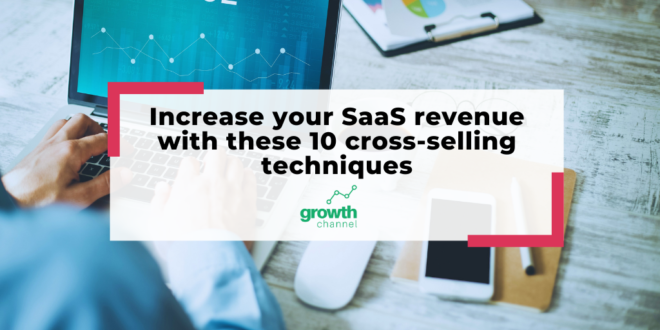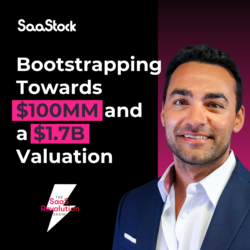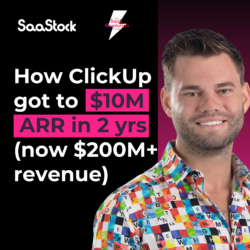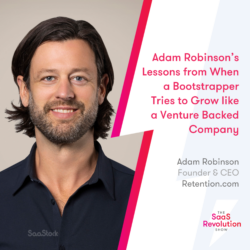This is guest blog post by Growth Channel.
Many times, SaaS companies become hyper-focused on attracting new leads and overflowing the top of their funnel, all while ignoring their current customers. However, these users can be a great source of additional revenue. They’ve already invested in your product, it costs less to retain them than it does to acquire new users (almost 5x less, according to some studies), and they’re more likely to understand the benefits of your product. By utilizing cross-selling, you can persuade current users to make additional purchases, increasing your SaaS revenue as a result.
The difference between cross-selling and upselling
Upselling occurs when a company tries to get a consumer to buy a premium, more expensive version of a product. An example of upselling is when a car salesman persuades you to buy a luxury model instead of the basic model, when the Starbucks barista asks if you want a grande instead of a tall, or when an employee at the Apple stores tries to get you to purchase the iPhone 12 Pro Max instead of the iPhone 11 SE.
Cross-selling, on the other hand, is when a company tries to get someone to spend more money by purchasing additional, related products. An example of cross-selling is when the car salesman tries to sell you a vehicle protection plan, when the barista asks if you want a pastry with your coffee, or when the Apple employee asks if you want to purchase Airpods or a case along with your new phone.
SaaS companies can benefit from both cross-selling and upselling, but in this article we specifically focus on the benefits and strategies of cross-selling. Let’s dive right in!
Cross-selling examples for SaaS companies
Of course, every SaaS company’s method and style of cross-selling will differ based on the specific products and services they offer. However, there are many examples of cross-selling that most SaaS companies can implement:
- Premium support
- Product training
- Exclusive webinar access
- Educational classes
- Add-ons and integrations
- Additional modules
- Additional products
- Dedicated Account Manager
- And the list can go on…
10 cross-selling techniques to increase your SaaS revenue
1. Offer different pricing plans
Instead of having one subscription price that unlocks all the features of your product, offer different pricing plans. There are two ways to do this. First, you can offer a base plan, which is cheap and simplistic, and then add additional pricing tiers and increase the number of available features. For example, Growth Channel, a marketing planning SaaS, offers three pricing tiers: free, member, and marketer, each increasing in price and features. In this scenario, you probably want between two and four different pricing plans. This gives customers more customization choices and allows you to charge premium prices for premium features. Plus, you can take advantage of psychology, as research has shown that the inner choice between two extreme price points is more attractive, known as the compromise effect. For example, consumers are more likely to buy a $25 subscription if you offer $10, $25, and $50 options, compared to just offering a $10 and $25 plan.
A second option is to start with a simple base plan and sell individual features at extra costs. This gives maximum flexibility to the user, as they don’t have to pay for anything they won’t use. However, this option can be trickier to implement and more difficult to scale. You can also combine both pricing structures by offering tiered plans and additional add-ons. For example, Salesforce, a highly popular CRM, offers four tiers of pricing for its Sales Cloud product and over a dozen additional features that can be purchased at an extra cost. Just make sure to not overcomplicate. Instead, clearly communicate how a simple plan differs from add-ons to avoid a storm of customer support.
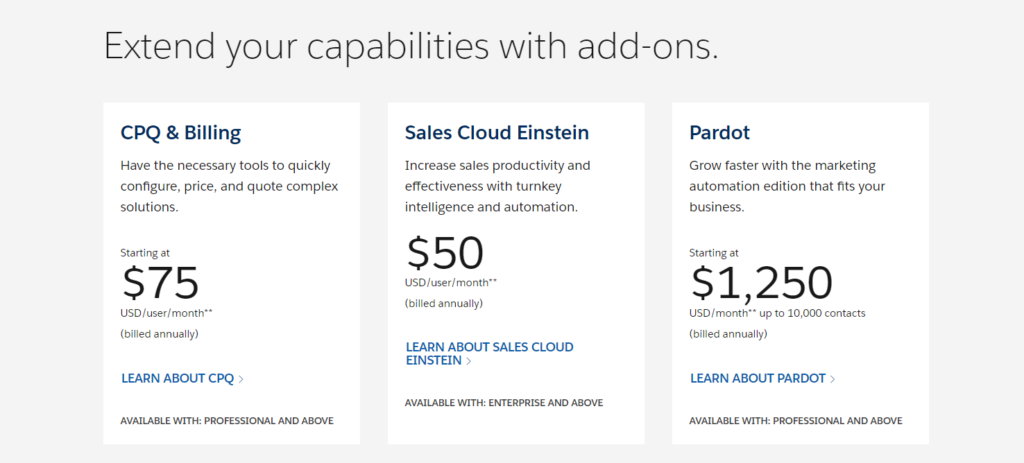 Source: Salesforce
Source: Salesforce
Once you establish your pricing structure, your goal is to get as many free or low tier subscribers to upgrade or purchase additional features. You will need to clearly explain why the added benefits are worth the extra cost. You can market your premium features to your lower tier customers through many channels, including a newsletter, email, social media post, blog, or video tutorial.
2. Make the benefits of your cross-selling offer clear
Oftentimes, users won’t complete the desired purchase because they don’t understand the value of your cross-sell or they don’t believe they need it. Your goal is to convince them otherwise, and you can do this by clearly communicating how the value of your product outweighs the additional cost. Instead of just listing features, highlight the benefits of your product. For example, a feature of a social media management platform is that users can post content to various platforms simultaneously. But the benefit is a simplified content creation process that allows users to save time for more important tasks. A feature of a video editing site is that it offers hundreds of filters, but a benefit is that users can easily create cinematic masterpieces without a blockbuster budget. To really emphasize the value of your cross-sell, include social proof such as testimonials, positive reviews, and recent media coverage.
It’s also important to show how your product or service actually works. If someone doesn’t understand exactly what they’re paying for, they’ll be less likely to convert. Here are a few strategies to try:
- Include actual images or screenshots of your platform, rather than generic stock photos
- Create a video tutorial explaining the feature or module you’re trying to cross-sell
- Offer personalized demos
- Lead introductory webinars
- Present at industry-related events
- Create a blog post discussing how a certain platform or feature works
- Include testimonials showing how your cross-sell helped real people solve their problems
3. Cross-sell to your power users
It can be beneficial to promote extra products, features, and services to your power users, or the users that are most engaged and involved with your SaaS, because these users are more likely to convert. You don’t want to spend time and money cross-selling to users who aren’t invested in your SaaS, because they likely won’t make additional purchases. To determine if someone is a power user, consider the following questions:
- Are they highly engaged with your product or company?
- How much time do they spend using your product?
- Have they left feedback or a review in the past?
- Do they open or respond to your emails?
- Have they been a customer for a long time?
- Have they renewed their subscription in the past?
- Did they purchase additional products or features from you in the past?
4. Use in-app notifications
Depending on your SaaS, you can use in-app notifications to alert users when they’ve reached a certain limit in their current plan, like contacts, storage, messages, or a number of users. Make sure to include a call to action like a button or a link that directs the user to the beginning of the upgrade process. Slack, a business communication platform, offers many forms of in-app notifications alerting users that they need to upgrade to access older messages, upload additional files, or add more integrations.
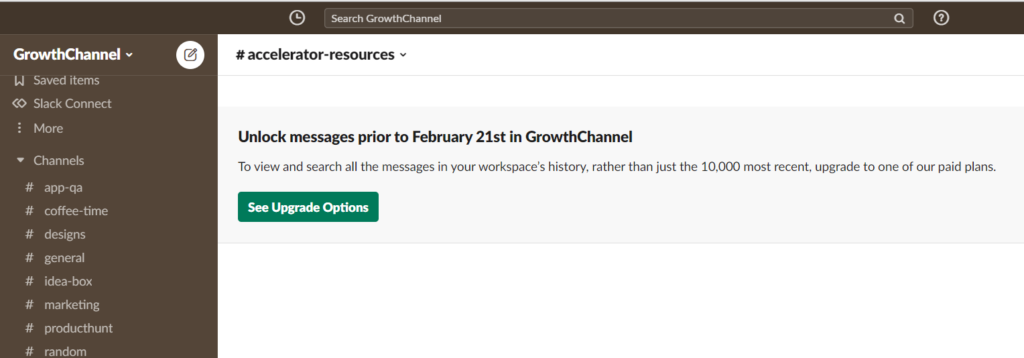 Source: Slack
Source: Slack
5. Update all your users about new products and paid features
When you release a new product, feature, module, or a webinar, it may only be available to users on a premium pricing plan. However, you should still communicate your cross-sell to all your users. Your goal is to create desire for your additional products in the minds of your customers. If users don’t know your additional products exist, you’ll never cross-sell successfully! You may find that simply explaining the value of your cross-sell and showing users what they’re missing out on is enough to convince someone to upgrade and make the desired purchase. For example, if you’re releasing a new module that only premium members can purchase or access, promote it in your newsletter and include a CTA that lets free users upgrade to a premium plan and then easily purchase the additional module. The graphic design website Canva uses this strategy by promoting new Canva Pro features to all newsletter subscribers, which entices free users to purchase a paid account.
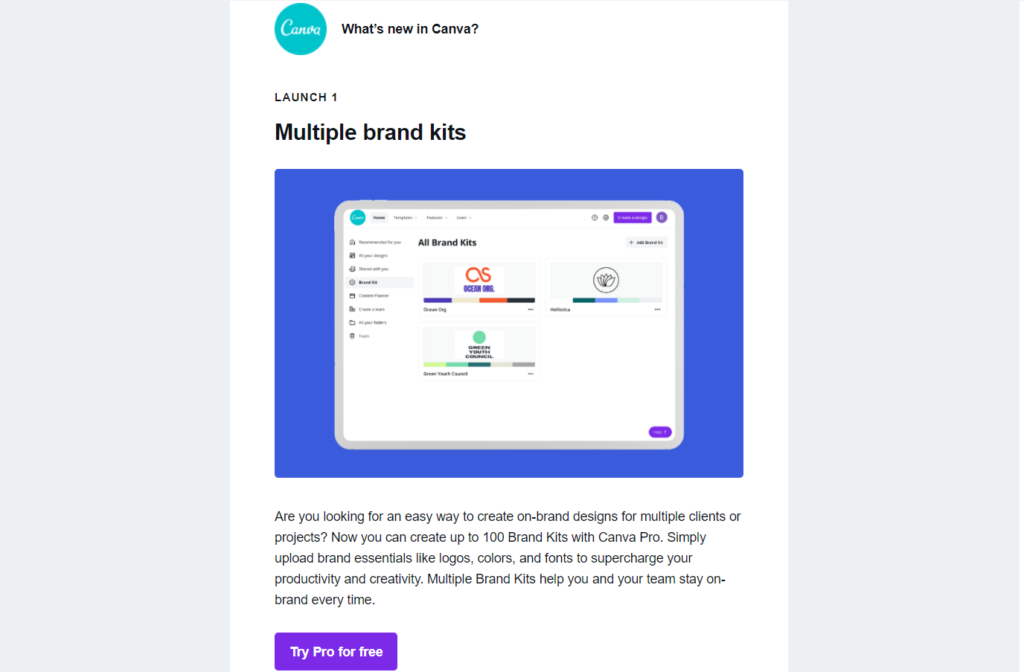 Source: Canva
Source: Canva
6. Include paid features within your app, but lock them for non-paying users
If you offer additional paid features, modules, or integrations within your app, make sure they are visible to all users. Like before, you don’t want to hide your cross-sells. Have the features be locked and inaccessible to users who haven’t purchased them yet. This way, they can see you’re offering more valuable add-ons, but they can’t actually use them. When users attempt to access the locked sections of your app, include a pop-up telling them that they need to upgrade or make an additional purchase in order to gain access. The pop-up should also include a CTA directly linking to your app’s shopping cart.
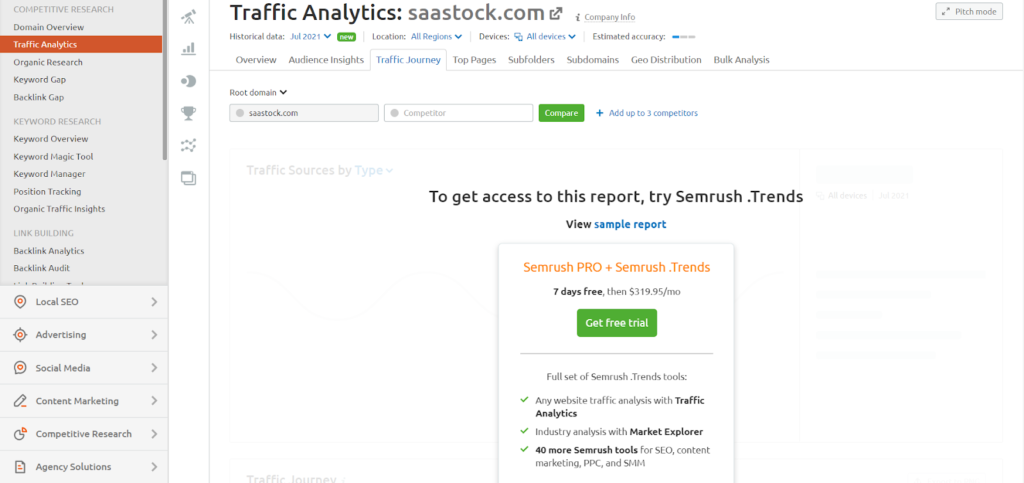 Source: SEMrush
Source: SEMrush
7. Create a sense of urgency
Creating urgency is a great way to encourage users to make a purchase. It incentivizes users to act quickly and not miss out. Limited time or exclusive offers are a great way to generate urgency. For example, you can host a one-day live event, discontinue content or products after a certain time period, or only offer a class during the summer. You can also promote deals and discounts with expiration dates. For example, you can offer 20% off to users who make a purchase before the end of the month or run a BOGO sale only on Cyber Monday. ProductLed used this strategy to promote their new PLG Certificate program, offering special bonuses to the first fifteen applicants:
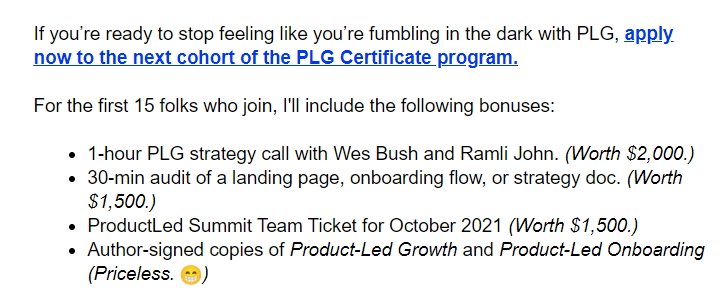
Source: ProductLed
8. Offer a discount or deal
Make your users feel special by offering a discount on your cross-sell. Discounts often create incentives for consumers to act the way you want them to. If someone is on the fence about making a purchase, a small discount may be enough to persuade them to follow through. Deals can take many forms, including sales, clearance, mark-downs, free shipping, percent discounts, coupons, product bundles, referral discounts, buy-one-get-one, and free gifts. Experiment with the different options to find what works best for your SaaS. Here are a few ideas for you to consider:
- Have a discount code pop up when users attempt to abandon their shopping cart.
- Give exclusive discounts to users who attend a webinar, class, training, or other event. For example, the department store Macy’s offers 25% off for customers who sign up for their newsletter.
- Send discounts to users who comment on your social media posts. For example, meal delivery service HelloFresh used their chatbot to automatically send Black Friday promo codes to users who commented the right answer to a riddle posted on Facebook. The campaign had a 68% conversion rate in 2018, with over half the recipients using their promo code to place an order. Learn more about their AI-driven campaign here.
- Reward your highly engaged users or long term customers with a discount on a newly released upgrade or feature.
- Offer a free gift to users who spend above a certain price point.
- Markdown your prices slightly during the holiday season. For example, Best Buy offered $400 off select laptops during its back to school sale.
- If you sell individual products, modules, or classes, run a buy-one-get-one free deal.
- Send discount codes to users who leave a review or refer a friend to your business. For example, the popular newsletter Morning Brew offers swag to subscribers based on the number of people they’ve referred:
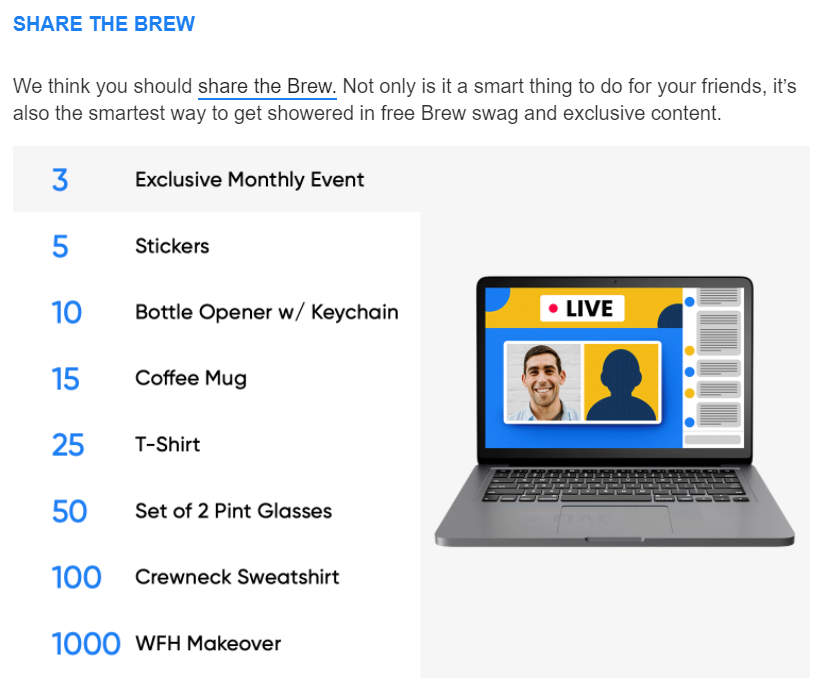
Source: Morning Brew
9. Pair products together wisely
In order to increase the likelihood of conversions, think carefully about the products you’re trying to cross-sell. Are they related? Does it make sense that the same customer would want to purchase both products? For example, a good pairing of products is when a grocery store puts marshmallows, chocolate bars, and graham crackers on the same end cap, because a consumer would likely purchase all three products together to make s’mores. For SaaS companies specifically, consider pairing a webinar with a guide that covers the same topic, a series of different classes that cover related topics, or an introductory training lesson with a free account. For example, MobileMonkey, a chatbot and marketing automation platform, promoted their guide to getting verified on Instagram in the same email where they offered free access to their InstaChamp Instagram DM automation tools. This pairing makes sense, as both the guide and the product are related to Instagram.
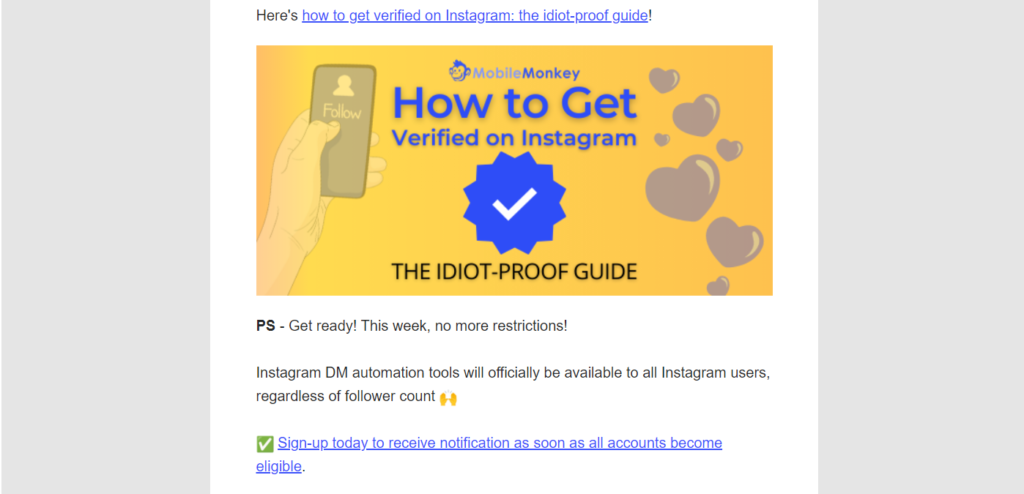 Source: MobileMonkey
Source: MobileMonkey
10. Don’t overwhelm your consumer
Sometimes, simple is better. The more complex your cross-sell offers are, the less likely a user will convert. If you offer too many choices or cross-sells at once, a user may get frustrated and abandon the purchase process completely. Also, make the process to upgrade or add more features as self-explanatory as possible. Make the progression of steps clear and improve areas where users typically make errors or abandon your cart. Try to simplify the process by eliminating any steps that are confusing or lack value. For example, don’t ask for data that isn’t absolutely necessary to your SaaS or the customer’s experience. You can use free tools such as Google Optimize, or more advanced such as Optimizely, to run experiments and test your hypotheses.
The art of cross-selling can be tricky, and you may find customers are hesitant to take the actions you want them to. Use these 10 techniques to guide you as you experiment with different types and methods of cross-selling. If you measure your progress and make improvements based on what resonates best with your specific audience, you’ll be cross-selling like a pro in no time.
Like these growth tactics? Access more growth marketing resources with Growth Channel.
About the author
Hailey Jennato is a Marketing Associate at Growth Channel, a SaaS startup that uses AI to generate data-driven marketing plans for businesses and agencies. She is passionate about telling stories in unique and creative ways. She also enjoys innovation, researching best practices, and writing about marketing trends. You can reach her on LinkedIn or email ([email protected]).
